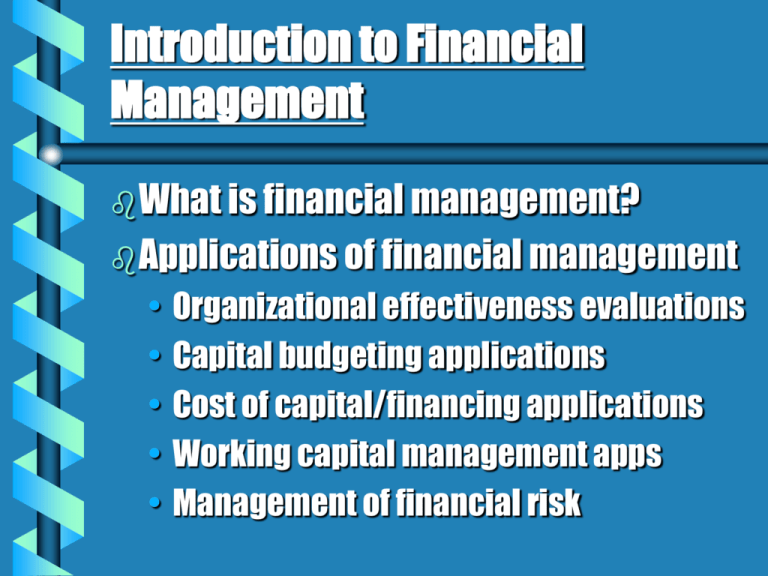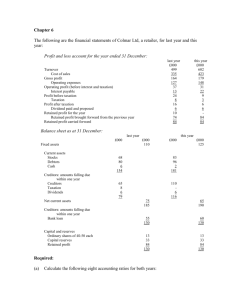Introduction to Financial Management
advertisement

Introduction to Financial Management What is financial management? Applications of financial management • • • • • Organizational effectiveness evaluations Capital budgeting applications Cost of capital/financing applications Working capital management apps Management of financial risk Introduction to Financial Management Managerial responsibilities Healthcare financial management challenges (NFP’s and Third Party Payment) Sub-disciplines of financial management • Accounting • Corporate finance Introduction to Financial Management Historical evolution of financial management within HSO’s • Cost accounting era • Contemporary financial management era • The role of TEFRA/PPS – Prospective payment methodologies – Shifting financial risk to providers – Lack of ability to shift risk by providers – Increased need for financial management focus Introduction to Financial Management The Environment of Financial Management • Organizational forms – Proprietorships (advantages, disadvantages) – Partnerships (advantages, disadvantages) – Corporations (advantages, disadvantages) – Hybrids (LLP, LLC, PC) • Ownership forms – For-profits (investor owned) – Not-for-profits (community owned) Introduction to Financial Management For-profit organizations • • • • Who are they? Vesting of ownership rights (stock) Public vs. private ownership Ownership “rights” – Right to control operations – Right to residual earnings – Right to proceeds from liquidation (after creditors) Introduction to Financial Management Not-for-profit organizations • • • • Who are they? Economic rationale for existence Vesting of ownership rights Characteristics – Tax exempt – Eligible for tax exempt financing (munis) – Qualify for tax-exempt charitable contributions Introduction to Financial Management FP vs. NFP organizations • Ownership does matter – FP - shareholder wealth maximization – NFP - accomplish charitable mission(s) • Financial management approaches do not differ appreciably between the two in reality Introduction to Financial Management Taxation Issues • The imperative of death AND taxes • Impact of taxation – Organizational performance/value – Financial management objectives • Levels of taxation – Proprietorships/partnerships -- ordinary income and capital gains – Corporations - ordinary income and capital gains Introduction to Financial Management Corporate taxation (cont’d) • • • • • Operating income Interest income from investments Dividend income from investments Capital gains income from investments Not-for-profit taxation issues – Tax exempt organizations - 501(c)(3)/501(c)(4) – Unrelated business income (UBI) Introduction to Financial Management Not-for-profit taxation issues • NFP investment sources of income – Use of “temporary cash surpluses” – Private inurement risks with excessive surplus funds and/or longer term investments Miscellaneous taxation issues • The use of financial leverage (debt) • “Double taxation” of corporate dividends Introduction to Financial Management Miscellaneous taxation issues • Carry-back/carry-forward provisions – Tax benefits with each provision Reimbursement Issues • Impact of reimbursement on organizational financial performance • The U.S. system of 3rd party payers • Market power among 3rd party payers Introduction to Financial Management Reimbursement Issues • Generic methods of 3rd party reimbursement – Fee for service -- cost-based, charge-based, prospective forms (DRG’s, APC’s) – Capitation – Non-payment • Financial management implications with different forms of 3rd party reimbursement Introduction to Financial Management Financial Management Implications of 3rd party reimbursement • Accounting for reimbursement revenues • Elements of financial risk • Provision of provider incentives – Fee for service – Capitation







